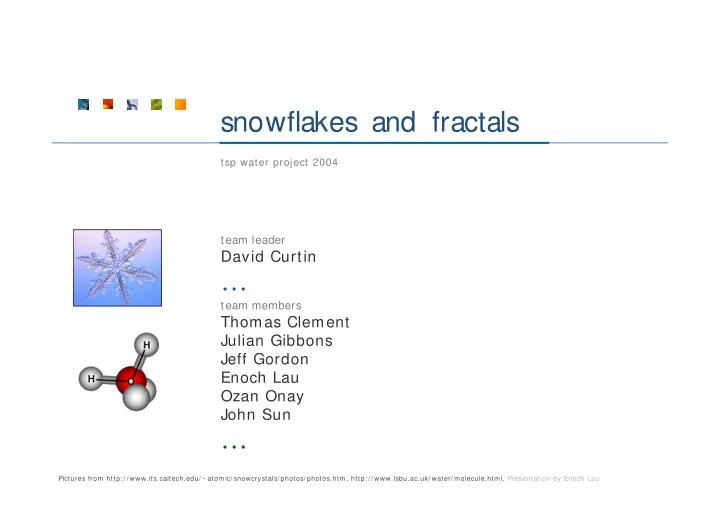

snowflakes and fractals tsp water project 2004 team leader David Curtin … team members Thomas Clement Julian Gibbons Jeff Gordon Enoch Lau Ozan Onay John Sun … Pictures from http: / / www.its.caltech.edu/ ~ atomic/ snowcrystals/ photos/ photos.htm, http: / / www.lsbu.ac.uk/ water/ molecule.html, Presentation by Enoch Lau
S nowflakes and Fractals • Mathematics Focus Group • Computing Focus Group Snowflakes and Fractals TS P Water Proj ect 2004 Picture from http: / / www.fractaldomains.com/ ronda/ joe/ ronda.shtml
L-S ystems • Iterative approach to fractal construction. • Repeatedly replaces line segments with pre-determined constructions. • Fractal is the result of infinitely many iterations. Before After F F + F – – F + F Snowflakes and Fractals TS P Water Proj ect 2004
Koch S nowflake Snowflakes and Fractals TS P Water Proj ect 2004
L-S ystem S nowflake Snowflakes and Fractals TS P Water Proj ect 2004
Metric S paces • Different definitions of distance. • Use the new definition to prove desired results. Snowflakes and Fractals TS P Water Proj ect 2004
Koch S nowflake • The Hausdorff metric is complete – all Cauchy sequences in it converge. • For Koch curve, Hausdorff distance translated into the height of the triangles added by each iteration (red). Snowflakes and Fractals TS P Water Proj ect 2004
Implications • The Koch curve exists – it does not spread out infinitely far. • The image we produce is unique – this method of generating fractals is not chaotic, but thoroughly systematic. • Snowflake formation follows a very different model! Snowflakes and Fractals TS P Water Proj ect 2004 END OF MATHEMATICS SECTION
S nowflakes on Computer Snowflakes and Fractals TS P Water Proj ect 2004 Picture from http: / / www.alunw.freeuk.com/ fractaltour.html
Physical Principles • Snowflakes are not merely frozen water, as they exhibit crystalline structures. • Variations in snowflake formation is due to dust particles, temperature and humidity. Snowflakes and Fractals TS P Water Proj ect 2004 Dust Picture from http: / / www.math.niu.edu/ ~ rusin/ known-math/ index/ tour_alg.html
Physical Principles Snowflakes and Fractals TS P Water Proj ect 2004 Picture from http: / / library.tedankara.k12.tr/ chemistry/ vol2/ hydrogen% 20bonding/ z20.htm
Diffusion Limited Aggregation • DLA approximates real-life snowflake construction. • Begin with a seed cluster in the middle. • Free particles move until they collide with the main cluster. Snowflakes and Fractals TS P Water Proj ect 2004
Grid-based Implementation • Matrix elements store different numbers to represent “on” and “off” positions. • By treating each element as two points, it behaves like a triangular/ hexagonal grid. Snowflakes and Fractals TS P Water Proj ect 2004
Grid-based Implementation • Triangular grid had no effect on symmetry. Snowflakes and Fractals TS P Water Proj ect 2004
Particle-based Implementation • Virtual particles move in a simulated environment. Sim ulated Environm ent Snowflakes and Fractals TS P Water Proj ect 2004
Particle-based Implementation QuickTim e version QuickTim e version Snowflakes and Fractals TS P Water Proj ect 2004
Particle-based Implementation • Fits the dimension equation very well: N ( r ) = k.r d 4 y = 1.48x + 0.99 Log(Particles) R 2 = 1.00 3 2 1 0 0 0.5 1 1.5 2 Log(Radius in pixels) Snowflakes and Fractals TS P Water Proj ect 2004
Conclusion Snowflakes and Fractals TS P Water Proj ect 2004
Recommend
More recommend